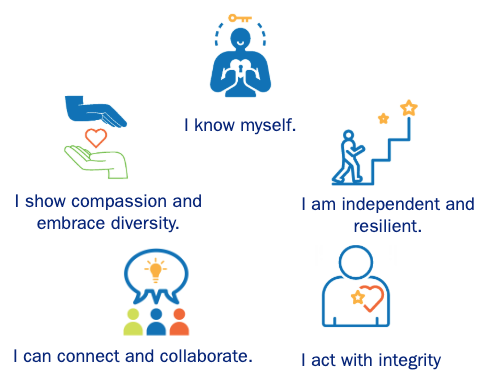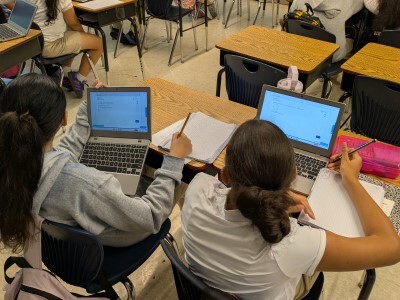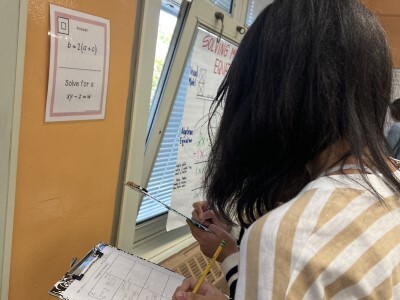Designing for Social Emotional Learning
Topics

We’ve all had the experience of truly purposeful, authentic learning and know how valuable it is. Educators are taking the best of what we know about learning, student support, effective instruction, and interpersonal skill-building to completely reimagine schools so that students experience that kind of purposeful learning all day, every day.
Two Rivers Public Charter School in Washington, D.C. promotes social-emotional learning by helping students develop self-awareness and self-regulation skills.
To succeed in college and have rich and varied options for their futures, students must develop competencies like self-awareness, self-regulation, collaboration skills, and relationship building skills. Consequently it has become abundantly clear that we in schools need to pay attention to the social-emotional learning (SEL) of our students. This isn’t news. However, we are still searching for the best ways to design systems that teach both academic and social-emotional learning.
As we have strived to live up to those goals at Two Rivers Public Charter School in Washington, D.C., I have realized that three design elements are essential to any program that teaches toward SEL outcomes. First, we need a set of shared definitions of the competencies that students are developing. Second, the social-emotional skills must be intentionally integrated with the rest of the curriculum. Last, but not least, students need time and space to receive feedback and reflect on their development of the competencies.
Shared Definitions of Social-Emotional Learning Competencies
It may be obvious, but we need shared definitions of the competencies we want students to develop so that we can agree on what we are talking about. However, shared definitions have to go beyond simple words on paper or a list of social-emotional learning standards. The definitions must be rooted in the connections between the language that we use to describe competencies and the experiences that students have where social-emotional skills are practiced.
For example, defining “Knowing Yourself” as the ability to identify your emotions, to develop an accurate self-perception, to recognize your strengths, and to advocate for yourself is a good start. Yet, these words mean very little to students. However, when students and teachers actually identify their emotions and share them with others, explain their perceptions of themselves and compare that to their experiences, discuss their strengths and weaknesses, and speak up for their needs, students and teachers develop a clearer understanding of what the words mean. Shared definitions are therefore the connection between descriptive language and concrete examples.
To aid us in creating this descriptive language at Two Rivers, we began with the five social-emotional learning competencies identified by the Collaborative for Academic, Social, and Emotional Learning (CASEL).
Rooting our team’s common language in these competencies provided a research-base for identifying a comprehensive set of social-emotional skills for all of our students.
Then as a community, we created what we call “scholarly habits” or student-friendly phrases that describe each of these five competences. These scholarly habits are easy ways for students and staff to understand and remember the competencies that we want every student to develop.

However, we realized more specific language and look-fors were necessary to flesh out the competencies and connect them to the experiences of our students. With that in mind, we created rubrics for each scholarly habit. We then identified specific look-fors that students and teachers could use as examples when applying these competencies in their day-to-day experience in school.
Integrating SEL into Curriculum
To foster the growth of these competencies in students, naming and defining the social-emotional skills is important but insufficient. Students need opportunities to develop them through practice. This practice may begin with role-playing the implementation of the key competencies. However, we have found that just practicing our scholarly habits in isolation does not support students in integrating them into their repertoire of life skills. Instead, after defining and unpacking the habits intentionally at the beginning of the year, we are mindful of how they show up and are integrated into our curriculum.
For example, the scholarly habit, “I am independent and resilient,” comes up regularly in class as students complete work. By naming for students that one of their goals in completing academic work is to be independent and resilient, we draw attention to the habit. Students then can begin to see how this competency can and should be a core part of their learning in school.
By integrating our scholarly habits into everything we do and not stopping to teach longer isolated SEL lessons around the habits, students see the habits as transferable core skills for school.
Time for Student Reflection, Feedback, and Revision
Once we defined the competencies for students and intentionally named where they are showing up in our day-to-day interactions, we need ways for students and teachers to evaluate their development. By collecting evidence of the implementation of the scholarly habits and aligning that evidence to the look-fors and our rubric language, we are able to paint a clearer picture of where students are in the development of these core competencies.
This then becomes a natural place for students to reflect on how they are developing their social-emotional skills. Specifically, we utilize the rubrics and look-fors as a place for students to pause within their classwork and pay explicit attention to their practice of social-emotional skills. By tying this reflection to the common language of a rubric and look-fors, our community calibrates what it means to demonstrate any of our scholarly habits.
In addition, the language of the rubric provides specific ways that teachers can give feedback to students to help them improve social-emotional competencies like coping skills for managing emotions or strategies for taking a more active role in group work.
Finally because these practices are embedded in the curriculum, students have natural places to revise their practice of scholarly habits. They can immediately apply the feedback that they receive related to a scholarly habit to work in the class.
Designing for Social-Emotional Learning
Each of the three design elements: 1. Defining the competencies, 2 Integrating them into the curriculum, and 3. Reserving space and time to reflect and provide feedback; are essential to learning and being able to transfer any content or skills. However, applying these ideas to social-emotional learning still isn’t the norm in most schools. It requires reorienting our goals to provide time to meaningfully unpack, teach, and assess the SEL skills we know students need to learn. This may appear to be at the expense of all of the academic content teachers and schools are under pressure to cover. However, knowing that these skills make a bigger difference in the long-term success of our students than much of that content, our students deserve that we slow down and pay more attention to the development of social-emotional learning competencies.
Photo at top courtesy of Two Rivers Public Charter School.





